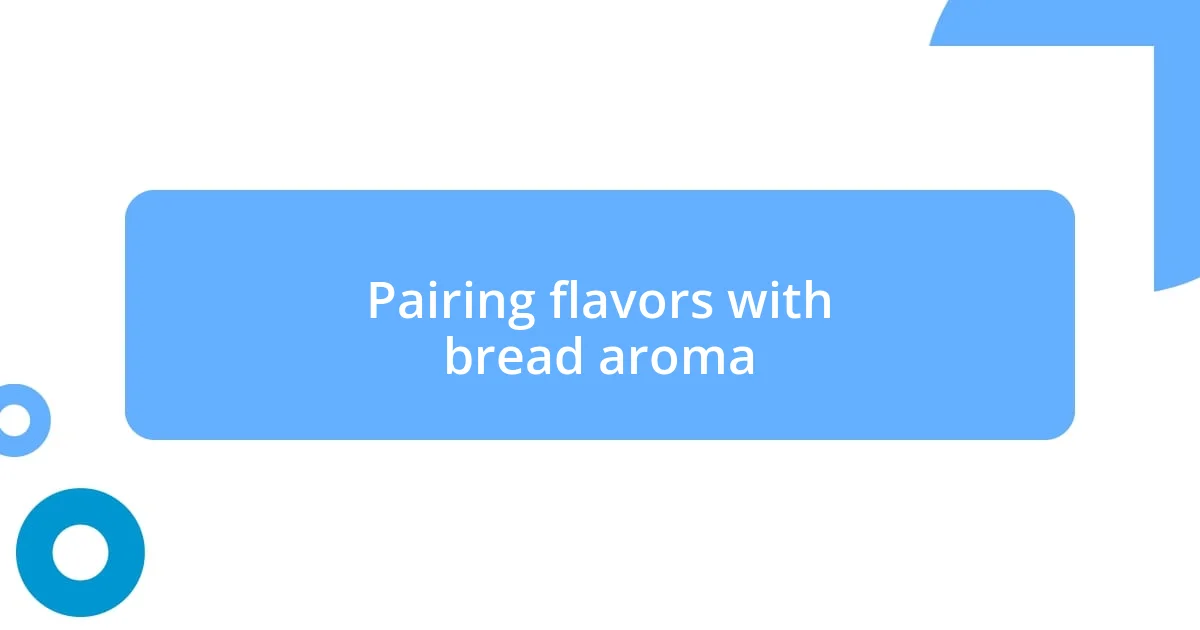Key takeaways:
- Bread aroma is influenced by various factors such as the type of flour, fermentation process, baking temperature, and added ingredients, each contributing uniquely to the overall scent.
- Techniques like using fresh herbs, pre-ferments, and steam during baking can significantly enhance the bread’s aroma, creating a more flavorful and aromatic experience.
- Pairing flavors, such as herbs and cheese, along with experimenting with different flours, can elevate both the aroma and taste of bread, creating memorable sensory experiences.

Understanding bread aroma
Bread aroma is an intricate blend of scents that can evoke warm memories and feelings of comfort. I recall the first time I walked into a bakery; the smell of fresh bread enveloped me like a hug. Isn’t it fascinating how a simple loaf can transport us back to our childhood kitchens, where the air was thick with tantalizing aromas?
At the heart of bread aroma are the volatile compounds created during the baking process, such as alcohols, aldehydes, and esters. Each of these compounds contributes to that irresistible scent that beckons us closer. Have you ever noticed how some breads smell sweeter, while others have a nutty or toasted aroma? That difference often stems from the type of flour used and the fermentation process, which can either enhance or temper those aromatic notes.
I’ve found that the environment can also influence the aroma we associate with bread. For example, baking on a rainy day seems to amplify those cozy smells, making your kitchen feel like a sanctuary. Can you imagine sharing a slice of fresh bread with a friend, the aroma mingling with laughter and conversation? It’s moments like these that show how deeply interconnected our senses are with our emotions and experiences.

Factors influencing bread aroma
The aroma of bread is affected by several key factors, each contributing its own unique notes to the final scent. For instance, the type of flour plays a significant role; whole grain flours often yield more profound, earthy aromas compared to refined white flours. I remember experimenting with spelt flour once, and the resultant nutty fragrance filled my kitchen – it was entirely different from my usual bread-making routine.
Consider the importance of fermentation time and temperature as well. Longer fermentation often enhances the complexity of aromas, as natural yeasts and bacteria develop deeper flavors and scents. Here’s a quick list of factors that influence bread aroma:
- Type of Flour: Different grains contribute varying scents, from nutty to sweet.
- Fermentation Process: The duration and method can intensify aroma complexity.
- Baking Temperature: Higher temps can create toasty, caramelized notes.
- Added Ingredients: Herbs, spices, and sweeteners can introduce unique scents.
- Humid Environment: Baking during humid conditions can amplify those comforting aromas.
It’s intriguing how each factor can shift the aromatic profile, making each loaf a unique experience. I often find myself savoring these moments, reflecting on how baking connects me to my surroundings and to the people I share my bread with.

Techniques for enhancing aroma
Enhancing the aroma of bread is truly an art, and I’ve discovered several techniques that can elevate the scent profile significantly. One effective method is incorporating fresh herbs, such as rosemary or thyme, into the dough. The moment those herbs hit the warmth of the oven, their essential oils release a delightful fragrance. I once added rosemary to a focaccia, and the aroma filled the entire house, drawing my family to the kitchen like moths to a flame.
Another technique worth trying is using a pre-ferment, like a poolish or biga. This method not only enhances the flavor but also amplifies the aroma. When I experimented with a biga, I noticed that the resulting loaf had a complexity that was previously absent in my bread. It was fascinating how a little patience transformed the scent into something extraordinary, creating not just a loaf but an experience that lingered long after the bread was gone.
Lastly, consider the role of steam during baking. Introducing steam in the initial phase helps develop a crust that seals in those wonderful aromas. I remember witnessing the transformation of a simple rustic loaf into a fragrant masterpiece by merely adding a tray of water to the oven. The resultant crust was not only gorgeous but also locked in the irresistible scent that filled my kitchen for days.
| Technique | Description |
|---|---|
| Herbs and Spices | Incorporating fresh herbs or spices into the dough releases essential oils during baking, creating a captivating aroma. |
| Pre-ferment | Using a pre-ferment like poolish or biga develops more complex flavors and aromas in the final loaf. |
| Steam Baking | Adding steam during the initial baking phase helps create a crust that locks in aromas and enhances the overall scent. |

Ingredients that boost aroma
When it comes to boosting aroma, the addition of specific ingredients can truly transform your bread. I love adding a touch of honey or malt to my dough; the smell of sweetness wafting through the kitchen is simply irresistible. Have you ever noticed how a small amount of sugar can create a warm, inviting scent that beckons everyone to gather around? It’s like an invisible thread, weaving itself into the fabric of family moments.
Another powerful ingredient is a splash of quality olive oil. I recall a time when I used an aromatic olive oil infused with garlic and herbs in my dough. The aromas that filled the house were nothing short of magical. It made me realize how much the quality of the ingredients truly matters. What if, from now on, we focused not just on the bread itself, but also on the scents each ingredient can contribute? Each time I bake with rich, flavorful oils, I’m reminded of my travels through Mediterranean markets, filled with the heady scents of fresh produce and spices.
Don’t overlook spices like cinnamon, nutmeg, or even cardamom. The moment I added cinnamon to my whole wheat dough, it was as if I had conjured up a warm, comforting hug. I still fondly remember that day – the aroma filled the air and instantly brightened my mood. Can you recall a time when a particular scent brought back cherished memories? That’s the magic that spices can add to your baking. By experimenting with these flavors, not only do you elevate the aroma, but you also create a tapestry of scents that speaks to your personal story.

Baking methods for aroma enhancement
One of my go-to methods for aroma enhancement is the use of a Dutch oven during baking. When I first tried this technique, I was amazed at how the enclosed space trapped all those lovely scents, intensifying the aroma as the bread baked. The crust that emerged was not only beautifully browned but also housed an enchanting fragrance that had my neighbors knocking on my door, eager to find out what was happening inside!
Another baking method that I swear by is varying the temperature throughout the baking process. I’ve found that starting with a higher temperature can give the bread a bold burst of aroma, like a gentle wake-up call for the yeast. There’s something magical that happens in those first moments in the oven. I vividly remember the thrill of peeking in and noticing how my bread sang with the scents of toasty goodness—what a moment of joy that was!
Finally, have you ever played with using different types of flours? I love experimenting with whole wheat, rye, or even spelt. The aromas they bring to the baking process are so distinct and inviting. I remember one Saturday morning, I substituted half of my usual flour with rye. The resulting loaf not only had a hearty texture but an earthy fragrance that lingered long after it was out of the oven. It made me wonder—how much more could I discover by simply swapping flours in my future bakes?

Pairing flavors with bread aroma
When pairing flavors with the aroma of bread, I often find that herbs can elevate the experience to new heights. A few sprigs of rosemary or thyme, kneaded into the dough, create an aroma that transports me outside to a sunlit garden. Have you ever baked a loaf where the scent of herbs mingled with the warmth of freshly baked bread? It’s as if the very essence of nature embraces you, inviting you to savor not just the taste, but the moment itself.
I remember experimenting with cheese once, adding sharp cheddar to a batch of sourdough. The combination of the rich, nutty aroma of the cheese with the tangy scent of the sourdough created an irresistible fusion that filled my kitchen. It made me ponder how certain ingredients can harmonize beautifully, enhancing both flavor and aroma. Can you recall an instance when an unexpected pairing surprised you? Those delightful surprises in cooking often lead to my favorite discoveries.
Don’t underestimate the power of complementary flavors, either. The sweet and slightly caramelized aroma of roasted garlic paired with a sprinkle of sea salt can transform a simple loaf into something divine. I still think back to that dinner party where I baked garlic bread that had my guests closing their eyes in blissful appreciation. How amazing is it that aromas can evoke such deep emotions and memories? It’s this kind of sensory connection that keeps me excited about exploring new flavor pairings every time I bake.














